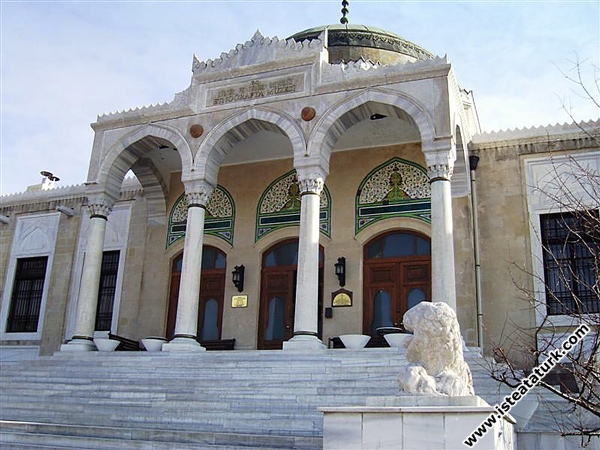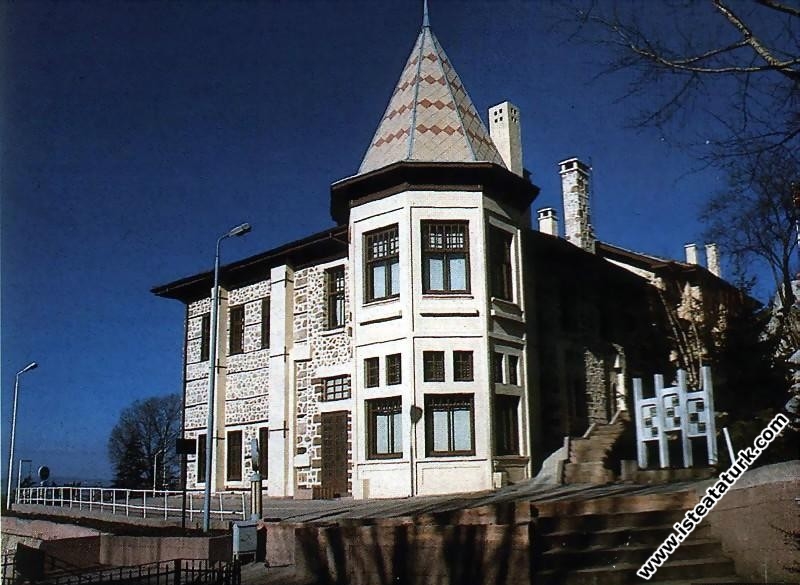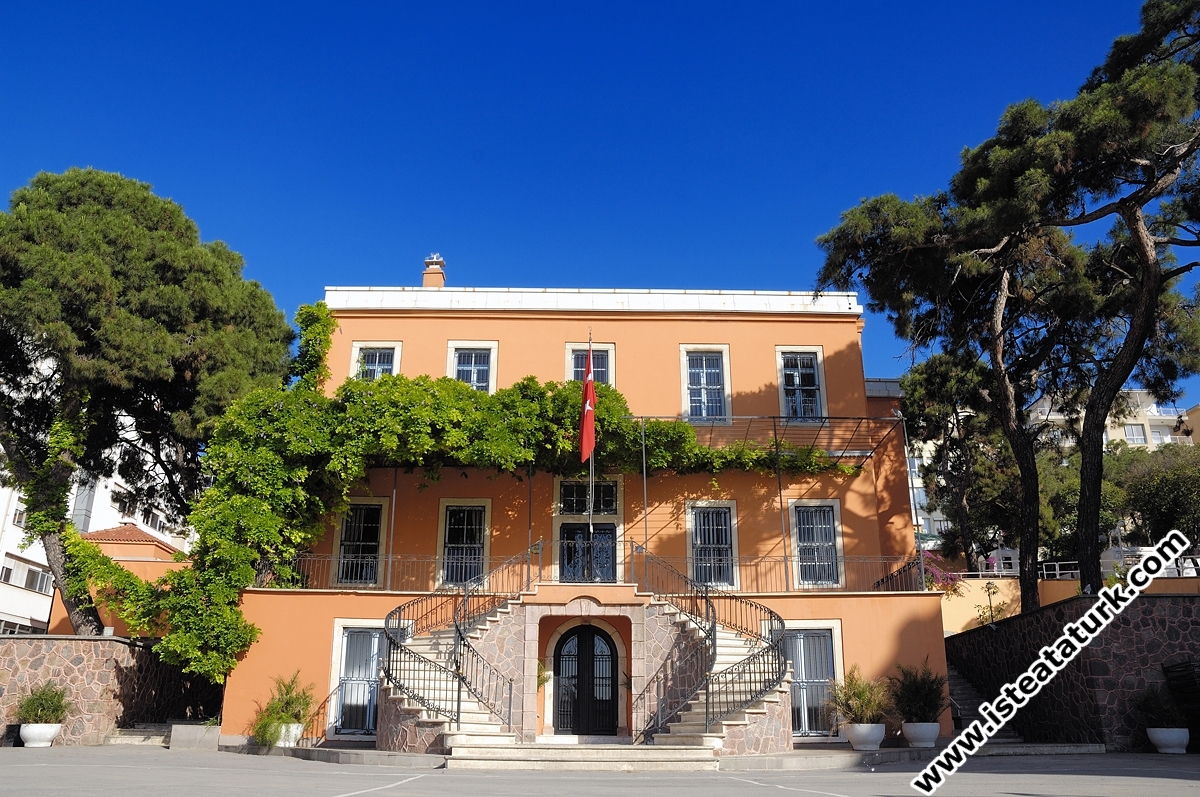
Ankara - Ethnography Museum
Character Size
Ankara - Ethnography Museum. “This is where Atatürk, who reached eternity on 10/11/1938, slept from 21/11/1938 to 10/11/1953.”
Ankara Ethnography Museum. (November 10, 1953)
Ankara - Ethnography Museum
Ethnography was established in the district of Ankara called Namazgah, on the hill which is a Muslim cemetery. The aforementioned hill was donated to the Ministry of National Education to be turned into a museum in accordance with the decision of the Council of Ministers dated 15 November 1925 by the General Directorate of Foundations.
The revolutionaries who took part in the War of Independence in Anatolia until 1924 and attached importance to national culture believed in the necessity of establishing an Ethnography Museum containing the material and spiritual cult heritage of the Turks. For this reason, Minister of National Education Hamdullah Suphi Tanrıöver said that his former colleague, Turcologist J. Meszaroş, one of the chiefs of the Budapest Ethnography Museum, was asked for his views on the establishment of the museum and he was offered service. It is understood from Meszaroş's report dated 29 November 1924 that he submitted to the ministry. Thus, in preparation for the establishment of the Folk Museum, Prof. Under the chairmanship of Celal Esad (Arseven), and then in 1925, under the chairmanship of Istanbul Museums Director Halil Ethem (Erdem), a special commission was established to collect and purchase artifacts. 1250 works purchased, It is exhibited in the museum, the construction of which was completed in 1927. Hamit Zübeyr Kosay has been appointed as the Museum Director.
Gazi Mustafa Kemal Pasha (Atatürk), who visited the museum on April 15, 1928, received information about the museum and ordered the opening of the museum due to Afghan King Amanullah Han's visits to Turkey. The museum was opened to the public on 18.7.1930 and remained open until the inner courtyard of the Museum was reserved as a temporary tomb in November 1938. Atatürk's body remained here until it was transferred to Anıtkabir in 1953. This part is still preserved as a symbolic tomb in homage to Atatürk's memory, with the following inscription written on white marble.
“This is the place where Atatürk, who reached eternity on 10.11.1938, slept from 21.11.1938 to 10.11.1953.”
It served as the Ethnography Museum Anıtkabir for 15 years. It has been a place of visit of heads of state, ambassadors, foreign delegations and the public. During this period, the work continued in the museum, and on 6-14.11.1956, due to the International Museums Week, necessary changes were made and it was opened to the public again.
The architect of the building, Arif Hikmet (Koyunoğlu), is one of the most valuable architects of the first period of the Republic.
The building has a rectangular plan and has a single dome. The stone walls of the building are covered with limestone. The pediment part is marble and they are decorated with carvings.
The building is accessed via a 28-step staircase. It has a triple entry system with 4 columns. When you enter through the door, you pass to the under-dome hall and from there to the columned part called the inner courtyard. A marble pool was built in the middle of this place, and the roof part was left open. Later, when this inner courtyard was reserved for Atatürk as a temporary tomb, the pool was transferred to the garden and its roof was closed. There are large and small halls symmetrically around the inner courtyard. The administrative part is adjacent to the museum and has two floors.
The bronze Atatürk Statue standing on a horse in front of the museum was commissioned by the Ministry of National Education in 1927 by the Italian Artist P. Conanica.
Ethnography Museum is a museum where examples of Turkish Art from the Seljuk Period to our time are exhibited.
Folk clothes, ornaments, shoes, clogs samples collected from various regions of Anatolia, women's and men's socks from Sivas region, various pouches, laces, circles, piqués, napkins, bundles, bedspreads, bridal dresses, groom's shaving sets are all a part of old traditional Turkish art. are representatives.
It has a collection of carpets and rugs from the regions of Uşak, Gördes, Bergama, Kula, Milas, Ladik, Karaman, Niğde, Kırşehir, which are among the centers of carpet weaving, with technical materials and patterns specific to the Turks.
Among the beautiful examples of Anatolian metalwork art are Mamluk cauldrons from the XV. century, Ottoman sherbet cauldrons, jug basins, trays, coffee trays, pans, bowls, wax scissors, etc. There are various metal artifacts.
There are Ottoman period bows, arrows, flintlock pistols, rifles, swords and bedpans, Turkish chinaware and Kütahya porcelain, items related to mysticism and sect, and plates from the fine examples of Turkish writing art.
One of the most beautiful examples of Turkish woodworking, Seljuk Sultan III. Keyhüsrev's throne (XIII. century), Ahi Şerafettin Ark (XIV. century), Nevşehir Ürgüp's Damsa Village Taşhur Paşa Mosque altar (XII. century), Siirt Great Mosque Mimber (XII. century) Merzifon Çelebi Sultan Madrasa Gate ( XV. century) is one of the important works of our museum.
VII. The collection, which Besim Atalay, a member of the Turkish Grand National Assembly, donated to the museum, includes Turkish art histories from various periods.
There is a specialized library in the museum, which includes works related to Anatolian ethnography and folklore, and art history.
Address: Talatpasa Bul. Opera / Ankara. Tel: (0312) 311 30 07
Source: www.kultur.gov.tr
ANKARA ETNOGRAPHY MUSEUM
Atatürk founded the Republic of Turkey on the ruins and ruins left by the First World War and the War of Independence in Anatolia. He made revolutions.
Its purpose was clear. With these revolutions, he was preparing his people for the advanced ages and the future.
Here, for example, dress and hat reform are included in such trends.
But it is very interesting. While the revolutionary movements continued, it was Atatürk who established the Ethnography Museum in the capital Ankara, which will exhibit traditional folk clothing and folk arts.
AFTER THE REFORMS
His aim here was probably to prevent the oblivion of the old folk arts, folk costumes, folk traditions, which would inevitably disappear after the reforms. In short, his wish was not to use (but to collect and display in museums) our ancient cultural products.
Probably Mustafa Kemal wanted to tell us:
“It is time to collect all the traditional items, devices, clothing, handicrafts and all works of art that our people have used in their daily life. Because, besides the reforms (and our current life, which will take new forms as a result of them), let's not forget the examples of our cultural heritage, which is destined to disappear. While adapting to the trends of the new age, let's collect and display the folk art examples of traditional culture in museums. This is the requirement of our personality and our age.”
Probably, Atatürk must have pursued this aim both by embarking on revolutions and establishing an ethnography museum. The logic of events leads us to this conclusion.
Thus, the foundation of the Ethnography Museum was laid in 1925, in the middle of Ankara, with Atatürk's wishes and directives.
This event is very thought provoking; worth dwelling on. Because Turkey, which had just come out of wars, was going through very difficult days at that time.
DESPITE IMPOSSIBILITY
The empire, which was behind the times, collapsed and disintegrated. Anatolia was completely burned and destroyed. The population was just over ten million. The staff available was very limited. The newly born Republic of Turkey would pay the debts of the Ottoman Empire. There was a lot of work to be done. However, the possibilities were very few.
But Atatürk, despite such intense problems and impossibilities; without wasting any time; It opens the doors of the Ankara Ethnography Museum, the foundation of which was laid in 1925, in 1930...
The event has to have a meaning...
Among many vital problems, the priority given to the Ethnography Museum... time, effort, budget...
The decision must be the result of very serious thought...
Of course, it cannot be said that the first ethnographic museum (the first step towards specifying folk arts) established in this way was complete. As a matter of fact, some works of principality, town and city arts and clothing were mostly displayed in the Museum; so.
But in the future, the Museum would acquire the character of a genuine ethnographic museum. Examples from the life of the mountain villages, plains and coastal villages in Anatolia would also be exhibited here. Because the name of the museum was Ethnography (Folk Arts) Museum. In addition, the phrase “the peasant is our master” belonged to Atatürk.
Mustafa Kemal was in a position to know his villagers closely and very well. Especially during the War of Independence, Anatolian villagers were closest to him (with his woman or man).
In any case, Atatürk had made and was able to make his revolutions because he knew the constitution of his villagers (people) very well.
INDUSTRIALIZED COUNTRIES
Despite these initial advances in designating folk art, we still can't say that we have an Ethnography Museum that exhibits Anatolian ethnography as Atatürk thought.
Despite Atatürk's statement "the villager is our master", the opening of the Ethnography Museum in 1930, and his other words about folk art, we could not "heartily" believe that the peasant could have a valuable and proud art. For this reason, we could hardly follow the path opened by Atatürk for folk art.
For example, there are still many of us who show the bindallı dress as the most typical example of our national women's dress.
However, today, when we research only the Yörük and Turkmen clothing and the places they use, we obtain results with such important information (hand-held, visible).
When we collect the tools and materials used by the villagers from birth to death; What interesting information we provide when we find out what and where they use their rugs and carpets in their daily lives.
When we present this unique information and pieces to the world in museums and books; What a rich and colorful Anatolian folk culture treasure that concerns all people.
Already in the 19th century, the industrialized countries of the world established ethnography museums (costume museums, handicraft museums, open-air village museums). They are still setting up.
Their aim is to show young people experiencing the industrial revolution what kind of life their society used to live. It is to save the past folk cultures from oblivion. It tells you where they came from and where they are going.
Industrial countries, which are not satisfied with this, also collect folk art products of countries that have not yet completed their industrialization; and they put them in their own ethnographic museums. They use such museums as important visual education centers for all people.
The children of industrial countries are brought up by visiting such museums; they are trained.
People can benefit from museums in every way. For example, inspired by the old folk culture, they add color and aesthetics to the industrial age in many areas. They bring the humane (peaceful) warmth of folk arts to our increasingly mechanized and robotic world.
LOOKING FORWARD
Atatürk was one of the rare people who saw this future very well.
He knew that his nation would experience a new age... The car would replace the oxcart... The tractor would replace the plow... The old fashioned "three in a row" dresses would be replaced by new fashionable clothes...
Photographs taken in those years prove this. Atatürk on a tractor... While Atatürk was traveling through Anatolia in his latest model car... Atatürk while attending the ceremonies wearing the latest fashion and a hat in his hand...
And besides this modernization (before the disappearance of the old folk arts), without wasting any time, he also starts his ethnographic studies and presents us the Ankara Ethnography Museum...
Thus, the era of ethnographic studies was opened in the young Turkish Republic, and archaeological excavations were also continued. Because the culture of the people still living above ground with the cultural remains lying underground were our cultural heritages.
However, ethnographic studies and ethnography museums (besides the underground excavations and the opened archeology museums) were not given the same importance. Studies on folk art are far behind. Costume museums, handicraft museums, open-air village museums could not be properly established.
However, most of the cultural (ethnographic) samples of the people living on the land (such as the archaeological artifacts under the ground) cannot wait for hundreds of years. Folk art works can be lost in the flow of time. It can erode, without a trace afterwards.
But although we know this situation, we could not give due importance to folk arts and traditions. If we had already, we would have (world-level) ethnography museums today.
In fact, ethnographic studies are not done at all. There are symposiums, exhibitions... But are these enough? I don't think so.
CONCLUSION
Here, the Ethnography Museum, which was established in Ankara at Atatürk's request in 1930, was a step forward in its time.
But then, it cannot be said that we followed that very advanced step of the 1930s with new steps.
From this point of view today, the Ethnography Museum becomes a mirror of our positive and negative attitudes. It reveals the need for us to try to complete a contemporary effort that we started in the 1930s.
In fact, this reminder was once again underlined with the death of Atatürk. Because Atatürk began his eternal rest here in 1938 (under the roof of the Ethnography Museum). From November 1938 to November 1953 (until he was transferred to Anıtkabir), his body remained in the Ethnography Museum.
The place where Atatürk's body remained for 15 years is still preserved in his memory. And, on the white marble stands the inscription: “This is where Atatürk, who reached eternity on 10/11/1938, slept from 21/11/1938 to 10/11/1953.”
Note: We would like to commemorate the late Hamit Zübeyir Koşay and Hungarian scientist Meszaroş, who lived in Turkey at that time, who contributed greatly to the establishment of the Ethnography Museum in Ankara. These two scientists, under Atatürk's command, rendered great service to Turkish ethnography. The late Kosay defended the idea of establishing an Open Air Village Museum in Anatolia throughout his life. We hope this wish will come true in the near future.
Sabiha Tansuğ
Source: ATATÜRK ARAŞTIRMA MERKEZİ DERGİSİ, Sayı 18, Cilt: VI, Temmuz 1990

